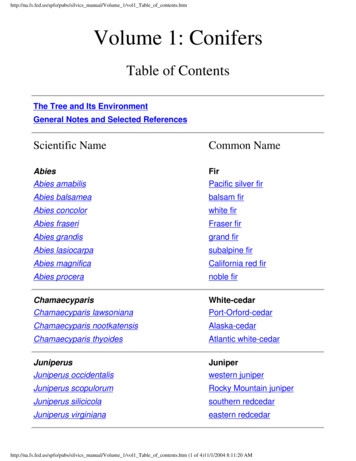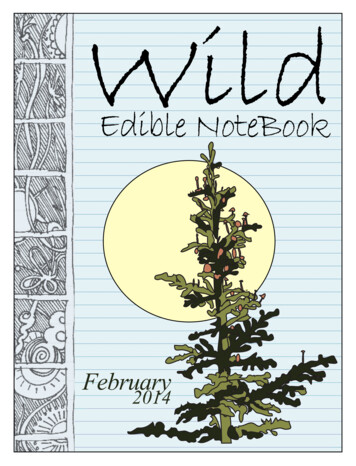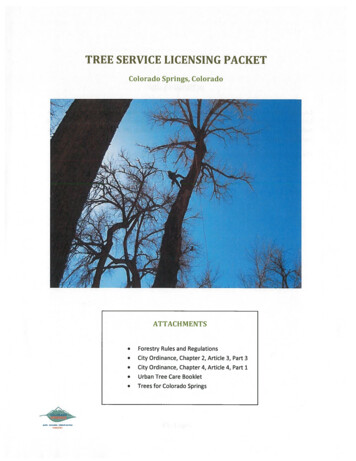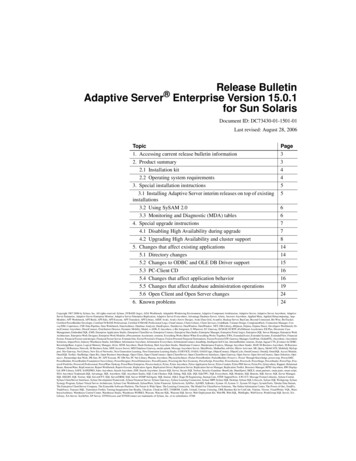
Transcription
http://na.fs.fed.us/spfo/pubs/silvics manual/Volume 1/vol1 Table of contents.htmVolume 1: ConifersTable of ContentsThe Tree and Its EnvironmentGeneral Notes and Selected ReferencesScientific NameCommon NameAbiesFirAbies amabilisPacific silver firAbies balsameabalsam firAbies concolorwhite firAbies fraseriFraser firAbies grandisgrand firAbies lasiocarpasubalpine firAbies magnificaCalifornia red firAbies proceranoble firChamaecyparisWhite-cedarChamaecyparis lawsonianaPort-Orford-cedarChamaecyparis nootkatensisAlaska-cedarChamaecyparis thyoidesAtlantic white-cedarJuniperusJuniperJuniperus occidentaliswestern juniperJuniperus scopulorumRocky Mountain juniperJuniperus silicicolasouthern redcedarJuniperus virginianaeastern redcedarhttp://na.fs.fed.us/spfo/pubs/silvics manual/Volume 1/vol1 Table of contents.htm (1 of 4)11/1/2004 8:11:20 AM
http://na.fs.fed.us/spfo/pubs/silvics manual/Volume 1/vol1 Table of contents.htmLarixLarchLarix laricinatamarackLarix lyalliialpine larchLarix occidentaliswestern larchLibocedrusIncense-cedarLibocedrus decurrensincense-cedarPiceaSprucePicea brewerianaBrewer sprucePicea engelmanniiEngelmann sprucePicea glaucawhite sprucePicea marianablack sprucePicea pungensblue sprucePicea rubensred sprucePicea sitchensisSitka sprucePinusPinePinus albicauliswhitebark pinePinus banksianajack pinePinus clausasand pinePinus contortalodgepole pinePinus echinatashortleaf pinePinus edulispinyonPinus elliottiislash pinePinus flexilislimber pinePinus glabraspruce pinePinus jeffreyiJeffrey pinePinus lambertianasugar pinePinus monophyllasingleleaf pinyonPinus monticolawestern white pinePinus nigraEuropean black pinePinus palustrislongleaf pinehttp://na.fs.fed.us/spfo/pubs/silvics manual/Volume 1/vol1 Table of contents.htm (2 of 4)11/1/2004 8:11:20 AM
http://na.fs.fed.us/spfo/pubs/silvics manual/Volume 1/vol1 Table of contents.htmPinus ponderosaponderosa pinePinus pungensTable Mountain pinePinus radiataMonterey pinePinus resinosared pinePinus rigidapitch pinePinus sabinianaDigger pinePinus serotinapond pinePinus strobuseastern white pinePinus sylvestrisScotch pinePinus taedaloblolly pinePinus virginianaVirginia pinePseudotsugaDouglas-firPseudotsuga macrocarpabigcone Douglas-firPseudotsuga menziesiiDouglas-firSequoiaRedwoodSequoia sempervirensredwoodSequoiadendronGiant sequoiaSequoiadendron giganteumgiant sequoiaTaxodiumBaldcypressTaxodium distichum var. distichumbaldcypress (typical)Taxodium distichum var. nutanspondcypressTaxusYewTaxus brevifoliaPacific yewThujaCedarThuja occidentalisnorthern white-cedarThuja plicatawestern s/silvics manual/Volume 1/vol1 Table of contents.htm (3 of 4)11/1/2004 8:11:20 AM
http://na.fs.fed.us/spfo/pubs/silvics manual/Volume 1/vol1 Table of contents.htmTorreya taxifoliaFlorida torreyaTsugaHemlockTsuga canadensiseastern hemlockTsuga heterophyllawestern hemlockTsuga mertensianamountain hemlockGlossarySummary of Tree CharacteristicsChecklist of Insects and MitesChecklist of Organisms Causing TreeDiseasesChecklist of BirdsChecklist of MammalsIndex of Authors and Tree Specieshttp://na.fs.fed.us/spfo/pubs/silvics manual/Volume 1/vol1 Table of contents.htm (4 of 4)11/1/2004 8:11:20 AM
Abies amabilis DouglAbies amabilis Dougl. ex ForbesPacific Silver FirPinaceae -- Pine familyPeggy D. Crawford and Chadwick Dearing OliverPacific silver fir (Abies amabilis), also known as silver fir andCascades fir, has a gray trunk, a rigid, symmetrical crown, andlateral branches perpendicular to the stem. It contrasts strikinglywith the more limber crowns, acute branch angles, and generallydarker trunks of its common associates Douglas-fir (Pseudotsugamenziesii), western hemlock (Tsuga heterophylla), and mountainhemlock (T. mertensiana). The species name, amabilis, meanslovely.HabitatNative RangePacific silver fir is found in southeastern Alaska, in coastal BritishColumbia and Vancouver Island, and along the western and uppereastern slopes of the Cascade Range in Washington and Oregon. Italso grows throughout the Olympic Mountains and sporadically inthe Coast Ranges of Washington and northern Oregon. Near CraterLake, OR, Pacific silver fir disappears from the Cascade Rangeand then reappears at a few locations in the Klamath Mountains ofnorthwestern California. The major portion of its range liesbetween latitudes 43 and 55 N. (35).http://na.fs.fed.us/spfo/pubs/silvics manual/Volume 1/abies/amabilis.htm (1 of 21)11/1/2004 8:11:22 AM
Abies amabilis Dougl- The native range of Pacific silver fir.ClimateClimate throughout the range of Pacific silver fir is distinctlymaritime. Summers are cool, with mean daily temperatures of 13 to 16 C (55 to 61 F), and winter temperatures are seldom lowerthan -9 C (16 F) (35). Mean number of frost-free days rangesfrom 40 near tree line to more than 250 at low elevations (26).http://na.fs.fed.us/spfo/pubs/silvics manual/Volume 1/abies/amabilis.htm (2 of 21)11/1/2004 8:11:22 AM
Abies amabilis DouglLength of growing season also differs from year to year at a givenlocation. Mean annual precipitation varies greatly, ranging from6650 mm (262 in) on the west coast of Vancouver Island to anextreme low of 965 mm (38 in) on the eastern side of VancouverIsland. Average annual precipitation in the Cascade Range is morethan 1500 mm (59 in); winter snowpacks are as much as 7.6 m (25ft) deep (9). A summer dry season is characteristic of this region,but Pacific silver fir is dependent on adequate soil moisture duringthe growing season. It is most abundant on sites where summerdrought is minimal, such as areas of heavy rainfall, seepage, orprolonged snowmelt.Soils and TopographyPacific silver fir grows on soils developed from nearly every typeof parent material found in the Northwest. Layering in soil profilescaused by successive deposits of volcanic ejecta, colluvium, orglacial till is especially common (1,43). The greatest knowngrowth rates for Pacific silver fir occur at low elevations on finetextured residual soils from sedimentary and basaltic rocks (16).Growth is reduced on poorly drained or shallow rocky soils.In northern Washington and British Columbia, podzolization is thedominant process in well-drained soils under Pacific silver fir. Atypical podzol is characterized by strong acidity of organic (pH 3.3to 4.0) and mineral horizons, moderate to thick (3 to 45 cm; 1 to18 in) surface accumulations of organic matter, and moderate toextremely low base saturation. In Oregon, podzolization is lessstrongly expressed and soils are more shallow and rocky. Pacificsilver fir has been found on many soil suborders throughout itsrange: Folists in the order Histosols; Aquents, Fluvents, Orthentsin the order Entisols; Andepts, Aquepts, Ochrepts, Umbrepts in theorder Inceptisols; and Aquods, Humods, and Orthods in the orderSpodosols (35).At upper elevations in Washington, soils beneath Pacific silver firstands are generally low in available nitrogen, with availabilitydecreasing with age (44). External nutrient cycling is slow; a meannitrogen residence time as long as 120 years has been found in oldgrowth forest floors (24). Nitrification has not been found to occur.Availability of phosphorus tends to be low but availability of baseelements does not appear to limit plant growth (42). Internalcycling meets much of the annual nutrient requirements. Foliarnitrogen concentrations between 0.7 and 1.2 percent and foliarhttp://na.fs.fed.us/spfo/pubs/silvics manual/Volume 1/abies/amabilis.htm (3 of 21)11/1/2004 8:11:22 AM
Abies amabilis Douglphosphorus concentrations of 0.11 to 0.20 percent have beenreported (3,42,52). Pacific silver fir differs significantly fromwestern hemlock in its ability to accumulate specific elements (46).Pacific silver fir grows at sea level along the coast from Alaska tothe Olympic Peninsula; farther inland, it is absent at lowerelevations. Its range in elevation is narrowest in Alaska, 0 to 300m (0 to 1,000 ft), and greatest in the western Cascade Range ofWashington, where Pacific silver fir may be found from 240 to1830 m (800 to 6,000 ft). In British Columbia it is found from 0 to1525 m (0 to 5,000 ft) in elevation on western Vancouver Islandand from 180 to more than 1680 m (600 to more than 5,500 ft) onthe lower mainland. Pacific silver fir grows on the highest ridgesand peaks in the Coast Ranges of Washington, from 365 to 850 m(1,200 to 2,800 ft). In the Olympic Mountains, it is thepredominant montane species up to 1400 m (4,600 ft), with lowerlimits at sea level on the west side and at 360 m (1,200 ft) in thecentral mountains. It is found between 610 and 1830 m (2,000 and6,000 ft) in the Cascade Range in Oregon as far south as the dividebetween the Rogue and Umpqua Rivers. On the east side of theCascade Range, it is confined to high elevations, down to 1160 m(3,800 ft) in Oregon and 1000 m (3,300 ft) in Washington (30,35).Associated Forest CoverWestern hemlock is a common associate throughout most of therange of Pacific silver fir, in the Abies amabilis zone and portionsof the Tsuga heterophylla zone (9). Noble fir (Abies procera) is animportant associate in southern Washington and northern Oregon.Other associates west of the Cascade Range are Douglas-fir,western redcedar (Thuja plicata), and grand fir (Abies grandis),with Sitka spruce (Picea sitchensis) and lodgepole pine (Pinuscontorta) important near the coast. At subalpine elevations in theTsuga mertensiana zone (9), Pacific silver fir is associated withmountain hemlock, Alaska-cedar (Chamaecyparis nootkatensis),and subalpine fir (Abies lasiocarpa). Toward the eastern limits ofits range, it grows with a mixture of coastal and interior species:western larch (Larix occidentalis), western white pine (Pinusmonticola), lodgepole pine, subalpine fir, grand fir, andEngelmann spruce (Picea engelmannii). Shasta red fir (Abiesmagnifica var. shastensis) is an associate in the extreme southernportion of its range. Extensive pure stands of Pacific silver fir havebeen reported in the Mount Baker and Mount Rainier regions andelsewhere in the southern Washington Cascade Range (40).http://na.fs.fed.us/spfo/pubs/silvics manual/Volume 1/abies/amabilis.htm (4 of 21)11/1/2004 8:11:22 AM
Abies amabilis DouglPacific silver fir is a major species in the forest cover type CoastalTrue Fir-Hemlock (Society of American Foresters Type 226) (5).It is also found in the following types:205 Mountain Hemlock206 Engelmann Spruce-Subalpine Fir223 Sitka Spruce224 Western Hemlock225 Western Hemlock-Sitka Spruce227 Western Redcedar-Western Hemlock228 Western Redcedar229 Pacific Douglas-Fir230 Douglas-Fir-Western HemlockShrubs associated with Pacific silver fir are primarily ericaceous.Blueleaf huckleberry (Vaccinium deliciosum), Cascades azalea(Rhododendron albiflorum), and rustyleaf menziesia (Menziesiaferruginea) are common understory species at higher elevations;copper bush (Cladothamnus pyrolaeflorus) is important insubalpine British Columbia (2). Alaska huckleberry (Vacciniumalaskaense), big huckleberry (V. membranaceum), ovalleafhuckleberry (V. ovalifolium), and devilsclub (Oplopanaxhorridum) are widespread associates. At its lower limits ofelevation, Pacific silver fir is found with salal (Gaultheria shallon)and Oregongrape (Berberis nervosa).Common herbaceous associates are common beargrass(Xerophyllum tenax), bunchberry (Cornus canadensis), twinflower(Linnaea borealis), queenscup (Clintonia uniflora), dwarfblackberry (Rubus lasiococcus), strawberryleaf blackberry (R.pedatus), rosy twistedstalk (Streptopus roseus), coolwortfoamflower (Tiarella unifoliata), and deerfern (Blechnum spicant).Rhytidiopis robusta is a constant bryophyte associate.Major habitat types include Abies amabilis-Tsuga mertensiana/Vaccinium membranaceum-Rhododendron albiflorum on cold, wetsites at high elevations and Abies amabilis/Xerophyllum tenax onshallow coarse-textured soils at various elevations. Abiesamabilis / Vaccinium alaskaense is a widespread type on modalsites. Abies amabilis/Rubus lasiococcus, Abies amabilis/Streptopusroseus, Abies amabilis / Tiarella unifoliata, and Tsugaheterophylla-Abies amabilis/Blechnum spicant are herb-dominatedtypes found in moist habitats. The Abies amabilis / Oplopanaxhttp://na.fs.fed.us/spfo/pubs/silvics manual/Volume 1/abies/amabilis.htm (5 of 21)11/1/2004 8:11:22 AM
Abies amabilis Douglhorridum type occupies wet, alluvial habitats (2,9).Life HistoryReproduction and Early GrowthFlowering and Fruiting- Pacific silver fir is monoecious; selffertilization is possible because times of pollen dispersal and seedcone receptivity overlap on the same tree. Flowers differentiatefrom axillary buds of current-year lateral shoots in early July ofthe year before seed development (32). When receptive topollination, the seed cones appear purple, erect, and 8 to 16 cm (3to 6 in) tall on the upper surfaces of 1-year-old branches in theupper parts of tree crowns. Just before pollination, the pollen conesappear red, pendent, and usually abundant on the lower surfaces ofthe branches somewhat lower on the crowns than the seed cones.Cone buds burst the following May, and pollination occurs about 2weeks later-before vegetative bud burst. The pollen does notgerminate and begin forming its pollen tube until 4 to 5 weekslater, resulting in a 6-week delay between pollination andfertilization (7,33).Initiation of phenological events varies with latitude, altitude,aspect, weather, and snowpack and is apparently related to meansoil and air temperatures. For example, pollination may occur inmid-May at 900 in (2,960 ft) in central Washington but is delayeduntil mid-June at 1600 in (5,250 ft) and until late May in southernBritish Columbia (7,32,33).Seeds are fully mature in late August, and dissemination begins inmid-September- one of the earliest dispersal times for PacificNorthwest conifers. Initiation of dispersal is apparentlyindependent of altitude or latitude (7); most seeds are shed by theend of October but may be shed until the following April (21,33).Seed Production and Dissemination- Cone production begins atyears 20 to 30 (33,37). Good seed years vary from region toregion; a good seed crop generally occurs every 3 years (8).Pacific silver fir is not considered a good seed producer; thiscondition is attributed to frequent years of low pollen, theextended period between pollination and fertilization, andarchegonial abortion producing empty seeds (33). Percentage ofsound seed varies, with reports of 6.7 to 35 percent and 51 percenthttp://na.fs.fed.us/spfo/pubs/silvics manual/Volume 1/abies/amabilis.htm (6 of 21)11/1/2004 8:11:22 AM
Abies amabilis Douglin one location (4). Germinative capacity varies widely from 3 to70 percent- but averages 20 to 30 percent. Cleaned seeds rangefrom 17,200 to 45,860/kg (7,800 to 20,800/lb) (37).The seeds are heavier than seeds of most Pacific Northwestconifers except noble fir. Seeds each contain a single wing butoften fall from the upright cone axis by pairs on ovuliferous scales,as the bracts contort and tear themselves from the cone-a processthat does not require wind. When the seeds are dispersed by thewind, they do not carry far; unsound seeds are carried farther thansound seeds. In one study, only 9 percent of the sound seeds werefound more than 114 in (375 ft) from the stand edge, comparedwith 41 percent at the stand edge and 34 percent more than 38 m(125 ft) (4).Seedling Development- Pacific silver fir germinates in the springafter overwintering under snow. Germination is epigeal (37).Seedlings germinating on snow because of early snowfall or lateseed fall are generally short lived. Germination can occur on avariety of media: on litter humps and in moist depressions in thesubalpine zone; on edges of melting snowpack in subalpinemeadows; and in litter, rotten wood, moss, organic soils, mineralsoils, and fresh volcanic tephra (2,11,25). Survival is better onmineral seedbeds than on organic seedbeds. Early mortality ofseedlings is attributable more to germination on snow, adverseclimatic effects, and competing vegetation than to disease (18).Cool, moist habitats are best for germination, but full sunlightproduces maximum subsequent growth. Seedlings can also growunder dense shade; seedlings 8 to 12 years old and about 10 cm (4in) tall can frequently be found beneath older, closed forestcanopies. Seedlings that survive continue to grow very slowly,existing as advance regeneration that can be 65 to 110 years oldand only 45 to 200 cm tall (18 to 80 in). When existing as advanceregeneration, Pacific silver fir has flat-topped crowns caused byslow height growth relative to lateral branch growth.Seedlings are sturdy and erect and resist being flattened by litterand heavy, wet snow. Survival of Pacific silver fir as advanceregeneration at middle elevations, where western hemlock isprimarily found in openings, is attributed partly to its ability toresist being buried by litter after snowmelt (40). At the highestelevations, Pacific silver fir is found primarily in openings and lessfrequently beneath the canopy (38). Stems of seedlings growing onhttp://na.fs.fed.us/spfo/pubs/silvics manual/Volume 1/abies/amabilis.htm (7 of 21)11/1/2004 8:11:22 AM
Abies amabilis Douglslopes often have a "pistol-butted" sweep, caused by heavy snowcreeping downhill.Vegetative Reproduction- Although Pacific silver fir can produceepicormic or adventitious sprouts, it does not regenerate by stumpsprouting. Upturning of lower branches after tops of young treesare cut may resemble sprouting.Sapling and Pole Stages to MaturityGrowth and Yield- There is a broad range of height growth ratesof Pacific silver fir because of the wide variation of climates withelevation and latitude. Site index values (at 100 years) in southernBritish Columbia range from 12 to 46 m (40 to 150 ft) (26) andhave been negatively correlated with elevation in Washington(16). In subalpine tree clumps at higher elevations, Pacific silverfirs reach heights of 18 to 24 m (60 to 80 ft).The largest Pacific silver fir tree known was in the OlympicNational Park, WA. It was 256 cm (101 in) in d.b.h. and 74.7 m(245 ft) tall. Trees 55 to 61 m (180 to 200 ft) tall and more than 60cm (24 in) in d.b.h. are common in old-growth stands. Trees 500 to550 years old have been found on Vancouver Island and in theNorth Cascades National Park, WA. Maximum age reported is 590years (48).Early height growth from seeds is generally considered very slow;9 or more years are usually required to reach breast height.Juvenile height growth ranges from 10 to 40 cm (4 to 16 in) peryear, depending on length of the growing season (50). Plantedseedlings also grow slowly, with height increments of 3 to 15 cm(I to 6 in) for the first few years after planting (47). On productivesites at low elevations, Pacific silver fir is capable of much greaterrates, averaging 90 cm (35 in) per year above breast height onsome 30-year-old trees (16). Growth of released advanceregeneration is more rapid than early growth from seeds (20,49).After an initial lag following overstory removal (as by avalanche,windstorm, or clearcutting), growth rates of 50 cm (20 in) or moreper year can occur (49). When released from suppression, advanceregeneration trees change from flat-topped to more conical crowns(41).Pacific silver fir occasionally shows an abnormal height growthpattern, in which various sapling and pole-size trees curtail heighthttp://na.fs.fed.us/spfo/pubs/silvics manual/Volume 1/abies/amabilis.htm (8 of 21)11/1/2004 8:11:22 AM
Abies amabilis Douglgrowth for at least 1 year while adjacent trees grow normally.Causes of this phenomenon are not known.Height-age and site index curves for Pacific silver fir have recentlybeen constructed (23); however, little information on yield ofsecond-growth stands is available. Data from sample plots on avariety of sites (table 1) indicate that large volumes can beexpected from Pacific silver fir in pure stands or mixed withhemlocks. Close spacing and lack of taper are partly responsiblefor high volumes found in pure, even-aged stands of Pacific silverfir.Table 1-Volume yield of second-growth stands inWashington and British Columbia, dominatedby Pacific silver fir, based on sample plot data.Plot location Proportionof Pacificandsilver fir¹elevationWashington:KingCounty, 975mWhatcomCounty, 760mVancouverIsland, BC(28):Santa MariaLake, 533 mLabor DayLake, 922 mHaley Lake,1204 mHaley Lake,1119 mAge Density 1197http://na.fs.fed.us/spfo/pubs/silvics manual/Volume 1/abies/amabilis.htm (9 of 21)11/1/2004 8:11:22 AM
Abies amabilis DouglSarah Lake,116 mWashington:KingCounty,3,200 ftWhatcomCounty,2,500 ftVancouverIsland, BC(28):Santa MariaLake, 1,750 ftLabor DayLake, 3,025 ftHaley Lake,3,950 ftHaley Lake,3,670 ftSarah Lake,380 1055311117017,434trees/ft³/acreacre¹Based on the total nymber of trees in sample plots.Volume in old-growth stands is extremely variable, depending onthe mix of species and degree of stand deterioration. One denselystocked plot at 1100 m (3,600 ft) in the north Cascades had 1813m³/ha (25,895 ft³/acre), 83 percent Pacific silver fir by volume. Anolder, more open stand in the same area had 840 m³/ha (12,000 ft³/acre).Stands at upper elevations (predominantly Pacific silver fir) inwestern Washington carry large amounts of leaf biomass- 18 to 25t/ha (8 to 11 tons/acre); total standing biomass ranges up to 500 t/ha (223 tons/acre) in mature and older forests. Leaf area indexes of14 have been reported (14). A large proportion of the net primaryproduction is below ground in subalpine stands; this is apparentlya characteristic of the cool sites and low nutrient mobilization rateshttp://na.fs.fed.us/spfo/pubs/silvics manual/Volume 1/abies/amabilis.htm (10 of 21)11/1/2004 8:11:22 AM
Abies amabilis Douglrather than the species itself. Values of net primary production intwo upper elevation Pacific silver fir stands in western Washingtonwere determined (15). In the 23-year-old stand, total net primaryproduction was 18 000 kg/ha (16,060 lb/acre); in the 180-year-oldstand it was 17 000 kg/ha (15,170 lb/acre). Of this, the aboveground portion was 6500 kg/ha (5,800 lb/acre) and 4500 kg/ha(4,010 lb/acre) for the two stands, respectively. Woody growthmade up 65 percent of this amount in the younger stand, and 50percent in the older stand. The below-ground portion was 11 500kg/ha (10,260 lb/acre) and 12 500 kg/ha (11,150 lb/acre) for thetwo stands, respectively. Small conifer roots and mycorrhizaemade up 65 percent of this amount in the younger stand and 73percent in the older stand.Rooting Habit- Pacific silver fir seedlings have roots that moreclosely resemble a true taproot system than do western hemlockseedlings (38), and the roots can penetrate more compact soils thancan the roots of western redcedar, Sitka spruce, and westernhemlock (27). Seedlings can develop adventitious roots wherevolcanic tephra covers the original soil surface (1). Advanceregeneration has, small root-to-shoot ratios, and the roots arepredominantly in the organic layers. Mature Pacific silver fir canhave a relatively flat, shallow, platelike root system on poorlydrained or shallow soils or in areas where there is nutrientimmobilization in the forest floor (15). On soils wherepodzolization develops and organic matter accumulates, feedingroots become concentrated in organic horizons as a stand ages.Peak growth of seedling roots occurs when shoots are least active.Activity is high in early spring and late autumn even in cold soils.Roots can also be active during the winter when soil temperaturesare just above freezing; however, water conductance isdramatically reduced after seedlings are preconditioned to coldtemperatures (39). At upper elevations in both young and maturestands, a large proportion of annual biomass production is in theroot systems (15). Roots are intensely mycorrhizal at upperelevations, and Cenococcum graniforme is a major mycorrhizalsymbiont (45).Reaction to Competition- Pacific silver fir can grow in a varietyof stand development conditions. It can seed onto outwash afterglacial retreat (35), seed into burned areas, develop from advanceregeneration after removal of the overstory, and grow slowly froma suppressed tree into an overstory tree in more uneven-agedhttp://na.fs.fed.us/spfo/pubs/silvics manual/Volume 1/abies/amabilis.htm (11 of 21)11/1/2004 8:11:22 AM
Abies amabilis Douglstands where disturbances are minor.Advance regeneration may have a cone-shaped crown or canbecome flat topped, with lateral branch growth greatly exceedingheight growth. After extensive removal of the overstory, some (butnot all) advance regeneration can accelerate in diameter and heightgrowth and form a new forest (20).Even-aged, pure, or mixed stands vary in stocking but can havemore than 2,470 stems per hectare (1,000/acre). When crownsclose during the sapling and pole stages, understory vegetation isalmost completely eliminated by shade, causing an open forestfloor. Lower limbs become shaded and die, creating branchfreeboles. This condition may last 200 years (31).Eventually the overstory crowns abrade and let more light into theunderstory, allowing development of shrubs and advanceregeneration. This may occur after one to three centuries-probablydepending on site quality, spacing, and disturbance history-and hasbeen observed to last to age 500 years (31). Individual overstorytrees eventually die and advance regeneration grows slowlyupward, creating a multi-aged, old-growth forest with a majorcomponent of Pacific silver fir that will be self-perpetuating,barring a major disturbance. Pacific silver fir is referred to as theclimax species at mid-elevations of its range (9) because of itsability to survive in the shade and to emerge in all-aged stands.Because of its slow early height growth, associated species such aswestern hemlock, Douglas-fir, and noble fir initially overtopPacific silver fir when grown in the open. After the initialovertopping, on many sites Pacific silver fir appears to outgrowand become taller than western hemlock after 100 years (19). Oncool, moist sites at the upper extremes of the range of Douglas-fir,Pacific silver fir can stratify above Douglas-fir as well (40). Noblefir appears to maintain a height advantage over Pacific silver firindefinitely on all sites where both species grow.Pacific silver fir is one of the most shade-tolerant trees in theNorthwest. There is confusion regarding its relative shadetolerance compared with western hemlock. It has been describedas equal, greater, and less shade tolerant than hemlock (26,40). Itcan most accurately be classed as very tolerant of shade.Most silvicultural treatments of Pacific silver fir have dealt withhttp://na.fs.fed.us/spfo/pubs/silvics manual/Volume 1/abies/amabilis.htm (12 of 21)11/1/2004 8:11:22 AM
Abies amabilis Douglregeneration and early stocking levels after old-growth stands werelogged. Regeneration practices vary from clearcutting followed byburning and planting to clearcutting with reliance on naturaladvance and postlogging regeneration. Each practice successfullyobtains regeneration for certain sites and management regimes.Early stocking control-thinning sapling and pole-size trees to 495to 740/ha (200 to 300/acre)- is practiced to increase growth ratesof individual trees. Trees left in pole-size stands after thinningmarkedly increase in diameter growth and apparently respond tofertilization. Possible commercial thinning regimes, rotation ages,and regeneration plans for managed stands (where advanceregeneration may not be prevalent) are primarily in the planningstages.Young, post-harvest stands can develop densely from advanceregeneration. These stands may require thinning to maintaindiameter growth, to keep from buckling in heavy snow or wind,and to ensure advance regeneration before the next harvest.Damaging Agents- Pacific silver fir is easily killed by firebecause of its shallow rooting habit and thin bark. It has lowerresistance to windthrow than Douglas-fir, western hemlock, orwestern redcedar. It is susceptible to windthrow after heavy partialcuts (9), on the borders of clearcuts or partial cuts, and even inclosed canopy stands during strong winds. Resistance to breakagefrom snow and damage by frost is moderate. The foliage of Abiesamabilis and other true firs is more easily damaged by volcanictephra than is the foliage of associated conifers (22). Several typesof animal damage have been reported: heavy browsing byRoosevelt elk (34), bark stripping by bears in pole-size stands,clipping of terminal buds by grouse and rodents (13), and cuttingof cones and cone buds by squirrels.Pacific silver fir is susceptible to many types of insect damage.Seed chalcids (Megastigmus pinus and M. lasiocarpae) and conemaggots (Earomyia abietum) have been known to infest a highproportion of cones during good seed years (17). Western hemlocklooper (Lambdina fiscellaria lugubrosa) and western blackheadedbudworm (Acleris gloverana) are serious defoliators of mixedPacific silver fir and western hemlock stands in British Columbia.Many other loopers are of minor importance; two species thatcause periodic outbreaks the greenstriped forest looper(Melanolophia imitata) and saddleback looper (Ectropiscrepuscularia). The western spruce budworm s manual/Volume 1/abies/amabilis.htm (13 of 21)11/1/2004 8:11:22 AM
Abies amabilis Dougloccidentalis) also feeds on Pacific silver fir in pure and mixedstands.The silver fir beetle (Pseudohylesinus sericeus) and fir root barkbeetle (P. granulatus) can be very destructive together and incombination with the root rotting fungi Armillaria mellea,Heterobasidion annosum, Phelli
Abies amabilis Dougl Abies amabilis Dougl. ex Forbes Pacific Silver Fir Pinaceae -- Pine family Peggy D. Crawford and Chadwick Dearing Oliver Pacific silver fir (Abies amabilis), also known as silver fir and










